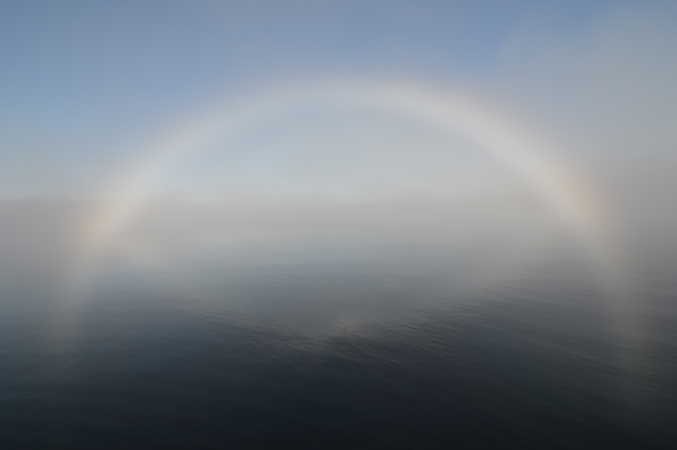Explainer: Rainbows, fogbows and their eerie cousins
With a little water and a glimmer of light, crazy sky displays can emerge, day or night
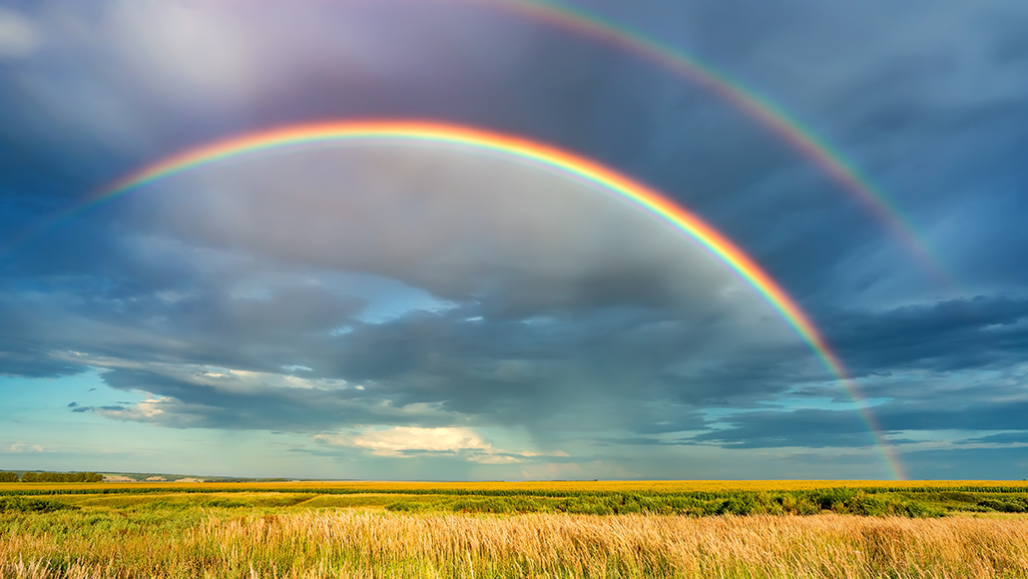
Rare double rainbow seen high in he sky. Note how the secondary arc is fainter, and the order of its colors is reversed.
sborisov/iStock/Getty Images Plus
Rainbows develop when sunlight passes through falling raindrops. As that light passes through water, however, it undergoes scattering. By bouncing off of particles in the water, that light no longer takes a straight, unimpeded path. Its intensity, too, can drop as some of the light is absorbed. Physicists refer to these changes as attenuation (Ah-ten-yu-AY-shun). That same thing happens when sunlight shines through a raindrop.
Rob Hart is the lead meteorologist for the National Weather Service in Charleston, W.V. “Sunlight actually has all kinds of colors in it,” he explains. “When the sunlight passes through raindrops, the water makes the sunlight bend.” Scientists refer to that bending as refraction.
Because each hue has a slightly different wavelength, each refracts a different amount. That refraction separates the colors and sends them out of the raindrop heading in slightly different directions. This transforms the sun’s light into a gorgeous arc across the sky.
Once in a while, the sunlight entering a raindrop is especially intense. When this happens, Hart notes, “Only certain parts and colors of the sunlight make it through.” A little bit of the leftover light reflects — bounces — off of the inside edge of the raindrop.
When that faint light hits the other side, it’s already been split apart into its colors. And because it’s a reflection, the colors have been reversed. That’s why, when you see a double rainbow, the secondary arc is much dimmer and its colors are flipped. It’s truly a “mirror image” of the primary arc.
Rainbows form opposite the sun. So to see one, make sure your back is to the sun and the rain in front of you. These colorful arcs usually develop in summer following an afternoon storm. As the rains depart (usually to the east), the late-day sun in the west can shine through the curtains of receding rain.
Rainbows come in many shapes and sizes. “The higher in the sky the sun is, the more challenging it is for the sunlight to bend enough to produce the colors of a rainbow,” says Hart. “Only very small rainbows are possible. But if the sun is lower in the sky, the better the chances are of a rainbow showing up. Those rainbows can be much bigger.”
That’s why if you see a rainbow at noon, it’s probably just barely above the ground. But if you see one at sunset, it will tower high into the sky.
Their colors can vary, too.
When the arcs form around sunrise or sunset, they tend to be almost totally red. The reason: When the sun is close to the horizon, its light penetrates through the atmosphere slantwise. That filters out more of the blue, green, yellow and violet hues. The result is a nearly one-color rainbow that blazes a fiery red-orange.
And did you know rainbows can literally go full circle? It’s true. If you’re on an airplane, a mountaintop or someplace high that offers a perspective down below, the rainbow won’t be an arc but a full circle. With no ground below to stop the prism-ing effect, it just keeps going.
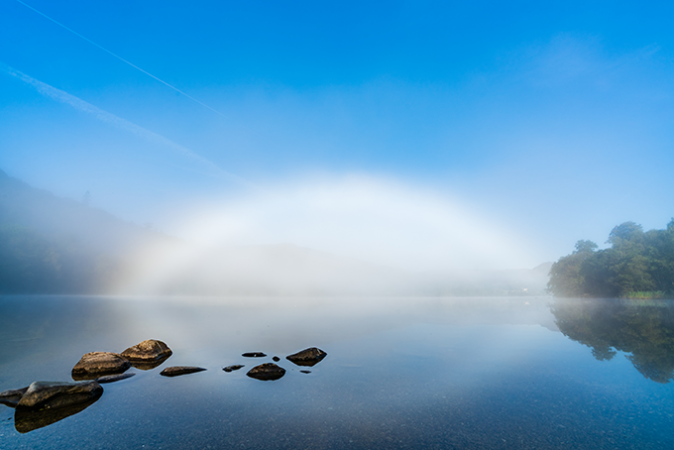
Ghostly cousins
If you’ve ever seen a pale, eerie white arc high in the sky, you might mistake it for a rainbow’s ghost. No haunting spirit, it’s actually a fogbow.
These form in much the same way as rainbows. Fog is a cloud of water vapor near to the ground. Like raindrops, the fog’s water can refract sunlight into its assorted hues. But hunting a fogbow down can be a challenge. That’s because if you’re near fog, you’re probably inside it. Fog doesn’t tend to have a sharp “edge” that permits sunshine to shine through it (as viewed from the ground).
How rare fogbows are “depends considerably on where you are on the planet,” says Les Cowley. He is a chemical physicist and creator of the popular website Atmospheric Optics. He specializes in the science of unusual sights in the sky.
Fogbows need both fog and sunlight. So regions prone to frequent fog and mist — such as San Francisco Bay, mountains or the Arctic — tend to have more fogbows.
The sun’s placement is important, too. It must be behind you, with the fog in front of you. You also need to know what to look for, as the fogbow is oddly white. And that has to do with the water droplets’ size.
Those droplets in fog are much smaller than raindrops. Individual droplets in a fog bank may only be a tenth of a millimeter (0.004 inch) across. In contrast, a raindrop’s diameter can be 20 to 30 times that size. And here’s why that matters. Tinier droplets let in less light. That will cast a much more subtle band of light against the sky. Smaller drops also refract less. Because the light doesn’t separate as widely, all of the colors overlap. That makes these bows mostly white, because white is the mix of all colors. Sometimes, there may be a hint of color. A bit of red may develop on the outside and bluish-purple on the inside.
Occasionally, a prisming cloud will not be at ground level, but higher up. Its droplets will be a bit bigger than fog’s, too. If enough of these droplets are packed densely enough in an area, they too can form a bow.
Indeed, notes Cowley, “Cloudbows and fogbows are the same phenomenon.” A cloudbow’s color will likely be somewhere in between the ghostly pale fogbow and the vibrant blazing shades of a thunderstorm’s rainbow.
From moonbows to mold-bows
Sometimes a rainbow can emerge at night. But without sunlight, it needs an alternative source of illumination — such as the full moon.
The physics of these moonbows are the same as for rainbows. They just use the moon rather than the sun as their light source.
Vanessa Alonso is a meteorologist who works at WCBI-TV in Columbus, Miss. “A moonbow is like a night rainbow,” she notes. “Produced by moonlight,” she explains that the moon needs to be near fully illuminated (at least 85 percent lit) to have enough light to make the arc.
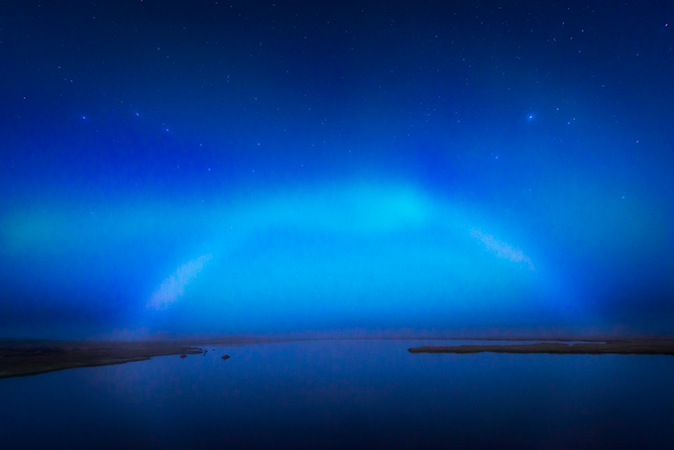
Other kinds of light bows can form without rain. Melting hail and fog can put a thin icy or watery glaze on the edges of hailstones or snowflakes. Once in a while, that too can squeeze out a rainbow.
Even mold spores can cause light to prism into a bow. Though it sounds a bit nasty, winds can blow fungi and mold spores like a thick cloud. Light can scatter as it passes through such a cloud. Some of the scattered light can overlap to produce an odd green/orange corona around the sun.
My experience
From August 5 to 24, 2018, I teamed up with 40 scientists from around the world. Some studied climate change. Others focused on ocean science. A few specialized in Arctic ecology. And at least one specialized in jellyfish and sea cucumbers. On August 7, we boarded the U.S. Coast Guard ice breaker Healy in Nome, Alaska, and sailed through the Arctic Ocean. Every 15 kilometers (9.3 miles) for two weeks, we analyzed the ocean water and the life within it.
At this region above the Arctic Circle in summer, the sun never sets. It just dips to skim the horizon, then rises up again. One sunlit evening, I knew the conditions were favorable for a fogbow.
Like magic, around 10 p.m. the sun became veiled in a misty fog. And yes, a fogbow emerged. It cast a ribbon of pure-white light.
I headed to the top deck. There I was high enough up to have fog both above and below me. That meant the fogbow would be both places. Indeed, it reached around to make a full 360-degree circle.
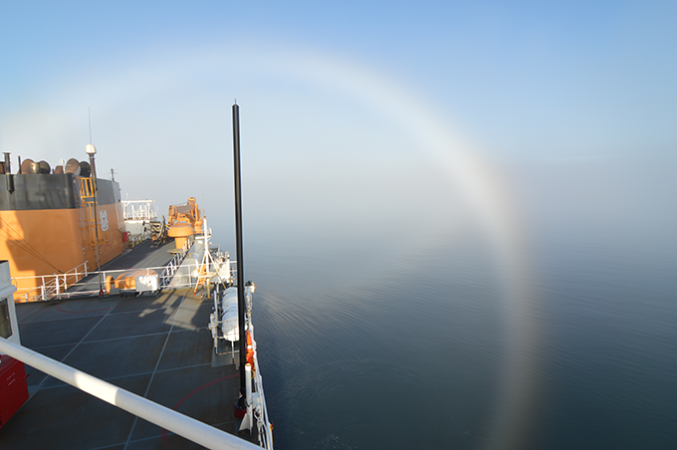
In fact, it became a reflected-light bow. Here, sunlight from the fogbow reflected on the ocean and then went back up toward the sky. This created an additional dim bow whose bottom hung below the primary arc.
Then something really special happened. Called a “glory,” it’s a bulls-eye that appears in the middle of a fogbow. It actually surrounded the shadow of my head!
The fog bank in question also happened to be freezing cold. But lacking dust particles on which to condense, the water droplets didn’t turn to ice. They just remained supercooled until they hit some surface. Then they flash froze. This coated the entire upper surface of the ship with a layer of rime ice. It was slippery, slick and dangerous.
Day or night, hail or fog, mold or rain, light can take a wide variety of paths, sometimes yielding optical delights. So keep your eyes peeled.
